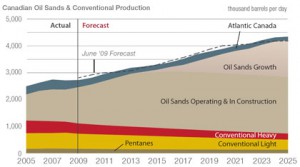BLOG ENTRY: Keystone Pipeline
BLOG ENTRY: Keystone XL Pipeline
The pending approval (or disapproval) of the Keystone XL pipeline has become a political football for the past few years. The project (shown in the diagram below) has become less about the facts and more about the rhetoric between Democrats and Republicans.
The Keystone Pipeline already exists, and it runs from Alberta, Canada to Crushing, Oklahoma. What’s pending approval from regulators is a 1,700 miles worth of expansion that would cut into two sections. The first section would connect Crushing, Oklahoma with the Gulf Coast (in Texas). This has gone into operation. The second portion would span from Alberta to Kansas, through the Bakken Shale region. At peak capacity, the pipeline will deliver 830,000 barrels of oil per day. Furthermore, it would offer the benefit of carrying US light crude oil and heavier Canadian oil harvested over tar sands. There is room for further exploration of this heavier oil as technological advancements continue. This second portion of the project is what is currently pending approval from the federal government.
The application for the pipeline extension was received by the State Department in May 2012, by TransCanada Corp., and the debate has continued since. In coordination with other federal departments, studies have been taking place on the economic and environmental impact of the proposed project.
Despite the potential benefits of increased access to Canadian oil and increased North American energy security, opponents have countered that opening a channel for carbon-rich, Canadian tar-sands oil would increase carbon emissions significantly. To convert the heavier product to usable oil, one of two methods must be used. Separating the carbon and hydrogen rich products, followed by the removal of the carbon rich component, is one method. The other option involves adding hydrogen to increase the hydrogen-to-carbon ratio of the resulting product, by mixing the initial product with a hydrogen-rich compound such as natural gas. Both processes require a significant amount of energy, often fueled by fossil fuels. Furthermore, environmentalists insist that Trans Canada will destroy the local ecosystems in the tar-sands basin.
An estimated 170 billion barrels of oil is recoverable, which would accommodate anticipated US demand for over 30 years. Oil production in Alberta tar sands totaled 1.9 million barrels per day in 2012, and is expected to double by 2022. Due to this growth (underscored in the graph above), one third of US imports of petroleum came from Canada in the last year. The potential economic benefits of this oil must be balanced with the environmental concerns discussed prior before a final decision is made.
While being sympathetic to environmental issues, I would urge the American government to approve the Keystone Pipeline extension. The proposed project would create 2,000 jobs, in addition to the added energy security. Furthermore, well over 60% of the public is polled to have support for the project. Specific poll numbers are shown in the pie chart below this paragraph. Disapproving the pipeline would not stop exploration from expanding in Canada (a sharp increase in carbon emissions from the region already is proof of this). Instead, we would simply be taking ourselves out of the group of parties that would directly benefit from the exploration. To address longer-term energy and carbon concerns, the US should still move forward in imposing strict new standards on power plants and increase car standards. This ensures that fossil fuel providers are not receiving a unconditional approval for their projects. Pairing these decisions together would address short-term energy demands, while concurrently limiting carbon emissions in the long-term.
References:
http://stateimpact.npr.org/texas/tag/keystone-xl-pipeline/
http://www.keystonepipeline-xl.state.gov/
http://harvardmagazine.com/2013/11/the-keystone-xl-pipeline
http://www.nationaljournal.com/congress/keystone-xl-pipeline-just-the-facts-20111208




One Response to BLOG ENTRY: Keystone Pipeline